BIBO Stability Analysis for Delay Switched Systems with Nonlinear Perturbation
Abstract
The problem of bounded-input bounded-output (BIBO) stability is investigated for a class of delay switched systems with mixed time-varying discrete and constant neutral delays and nonlinear perturbation. Based on the Lyapunov-Krasovskii functional theory, new BIBO stabilization criteria are established in terms of delay-dependent linear matrix inequalities. The numerical simulation is carried out to demonstrate the effectiveness of the results obtained in the paper.
1. Introduction
Time delay is a source of instability and poor performance and appears in many dynamic systems, for example, biological systems, chemical systems, metallurgical processing systems, nuclear reactor systems, and electrical networks [1]. Since the existence of time delays may lead to oscillation, divergence, or instability, considerable effort has been devoted to this area. As an important system performance index, BIBO stability means that any bounded input yields a bounded output and can be considered in many aspects, such as the free system dynamics, the basic single or double loop modulators, and the issues connected with bilinear input/output maps. Consequently, bounded-input bounded-output (BIBO) stability analysis of dynamical systems has attracted many scholars’ attention. For instance, in [2], BIBO stability criterion is derived for a three-dimensional fuzzy two-term control system, in [3], the problem on BIBO stabilization for a system with nonlinear perturbations is studied by discussing the existence of the positive definite solution to an auxiliary algebraic Riccati matrix equation, in [4], based on linear matrix inequality techniques, the stabilization criterion for uncertain time-delay system is presented to guarantee that bounded input can lead to bounded output, and in [5], BIBO stability for feedback control systems with time delay is studied through investigating the boundedness of the solutions for a class of nonlinear Volterra integral equations.
Recently, switched system becomes a research hotspot. Its motivation comes from the fact that many practical systems are inherently multimodal and the fact that some of intelligent control methods are based on the idea of switching between different controllers. Up till now, many investigations about stability of multiform switched systems have been carried out; see, for instance, [6–19] and references therein. Hence, it is our intention in this paper to tackle such an important yet challenging problem for BIBO stability analysis of delay switched systems. In addition, perturbations [20–26] and time delays [27–29] exist in many kinds of systems, and this makes the practical control problem complicated and has received much attention from scholars. Hence, in this paper, the BIBO stability for delay switched system with mixed time-varying discrete and constant neutral delays and nonlinear perturbation is concerned, and some original BIBO stability criteria are established in terms of linear matrix inequalities (LMIs). Finally, some simulation results are given to illustrate the effectiveness of our results. The main contributions of the paper are of two folds: (1) a delay-dependent technique is applied successfully into the analysis results process; (2) a Lyapunov-Krasovskii functional is constructed to derive a new form of the bounded real lemma (BRL) for the system under consideration.
The remainder of this paper is organized as follows. The model under consideration and some preliminaries are provided in Section 2. Section 3 presents the results on stability analysis. Section 4 gives an illustrative example. At last we conclude the paper in Section 5.
Notations used in this paper are fairly standard. Let Rn be the n-dimensional Euclidean space, Rn×m represents the set of n × m real matrices, the symbol * denotes the elements below the main diagonal of a symmetric block matrix, A > 0 means that A is a real symmetric positive definitive matrix, and I denotes the identity matrix with appropriate dimensions. diag {⋯} denotes the diagonal matrix. E{·} refers to the expectation operator with respect to some probability measure P. ∥·∥ refers to the Euclidean vector norm or the induced matrix 2-norm. The superscript T stands for matrix transposition. Ln,h = L([−h, 0], Rn) denotes the Banach space of continuous functions mapping the interval [−h, 0] into Rn with the topology of uniform convergence.
2. Model Description and Preliminaries
Lemma 1 (see [30].)For any constant matrices E, G, and F with appropriate dimensions with FTF ≤ kI, then
Lemma 2 (see [31].)For any positive definite matrix Φ ∈ Rn×n, a positive scalar γ, and the vector function w : [0, γ] → Rn such that the integrations concerned are well defined, then
Definition 3 (see [32].)A real-valued vector , if .
Definition 4 (see [32].)The control system with reference input r(t) is BIBO stable, if there exist some positive constants θ1, θ2, satisfying
Assumption 5. We assume that for system (1) there exist Hurwitz linear convex combinations of Ai; that is,
3. Main Results
In this section, we will establish some BIBO stability criteria using Lyapunov-Krasovskii functional theory and linear matrix inequalities.
Theorem 6. For given positive scalars h and k, switched system (1) is BIBO stable, if there exist ,,,,,, positive scalars ε, σ, matrices P2, P3, U, V, W, and symmetric positive definite matrices P, R, M, S, Q, satisfying
Proof. Since
Let
Define
4. Simulation Results
Remark 7. When the BIBO parameter k and the constant parameter β are given, the upper bound of time delay h of system (1) can be determined by solving the following optimization problem:
Now we consider the influence of parameters k and β on the maximal allowable delay in Tables 1 and 2.
| k = 0 | k = 0.1 | k = 0.2 | k = 0.5 |
|---|---|---|---|
| hmax = 3.3395 | hmax = 2.5482 | hmax = 2.1313 | hmax = 1.5197 |
| β = 0 | β = 0.1 | β = 0.2 | β = 0.5 |
|---|---|---|---|
| hmax = 2.6608 | hmax = 2.5482 | hmax = 2.4370 | hmax = 2.1385 |
Remark 8. From Tables 1 and 2, it can be seen that the maximal allowable delay decreases with the rise of the parameter k and increases as the parameter β is reduced.
Remark 9. Figure 1 depicts the time response of system reference input variable r(t), and Figure 2 depicts the time response of switching signals. sw1 denotes the switching signal added to the system for the first time, and sw2 denotes the switching signal added to the system for the second time; Figure 3 depicts the time response of system output variable Y1(t), and Figure 4 depicts the time response of system output variable Y2(t). The solid line denotes the output variable of the switched system with the switching signal sw1, and the dashed line denotes the output variable of the switched system with the switching signal sw2. From the figures it can be seen that the system output jitters in a range with a given bounded input after a period of time, which means that the system is BIBO stable and demonstrates the effectiveness of our theoretical results.
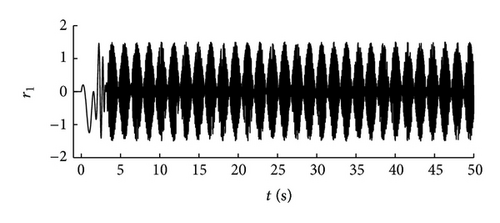
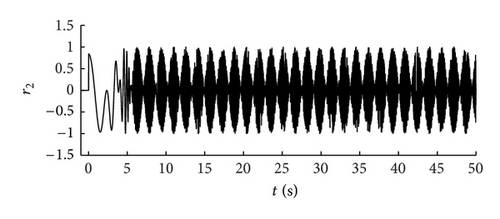
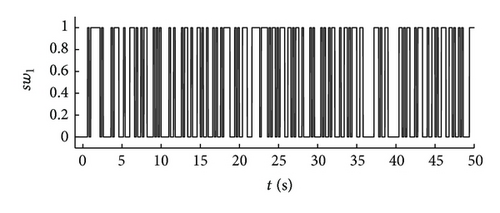
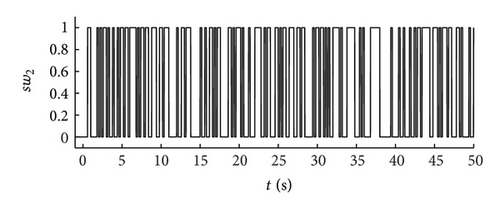
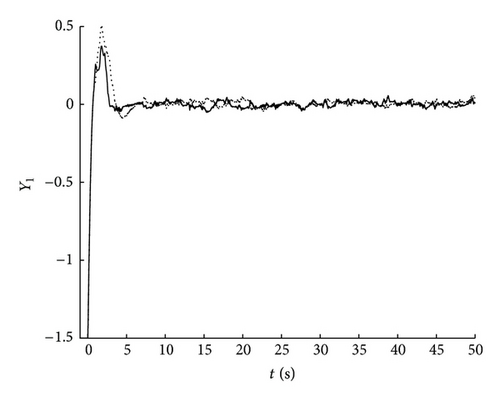
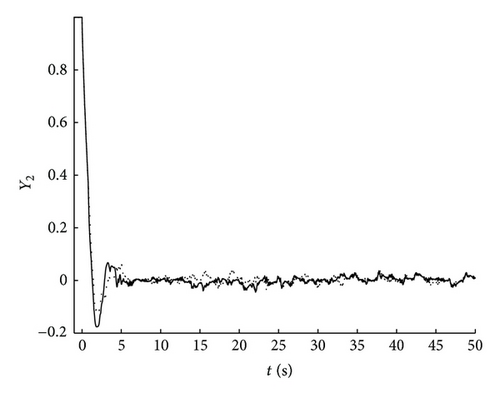
5. Conclusions
We have studied bounded-input bounded-output stability for a class of delay switched systems with nonlinear perturbation. Based on the Lyapunov-Krasovskii functional theory, new BIBO stabilization criteria were established in terms of delay-dependent linear matrix inequalities. Some numerical simulations have been conducted to demonstrate the effectiveness of the theoretical results obtained in this paper. Future work will investigate fault detection for delay switched systems.
Acknowledgments
This work was partially supported by the Key Projects of Xihua University (Z1120946), the National Key Basic Research Program, China (2012CB215202), the 111 Project (B12018), and the National Natural Science Foundation of China (61174058 and 61134001).




